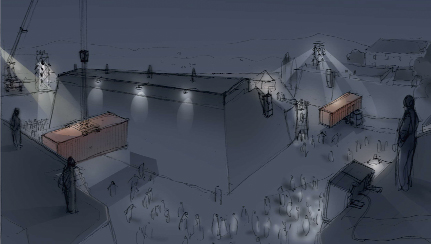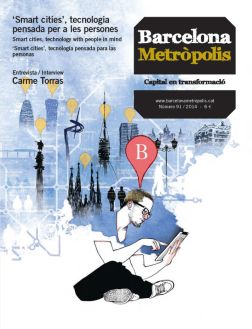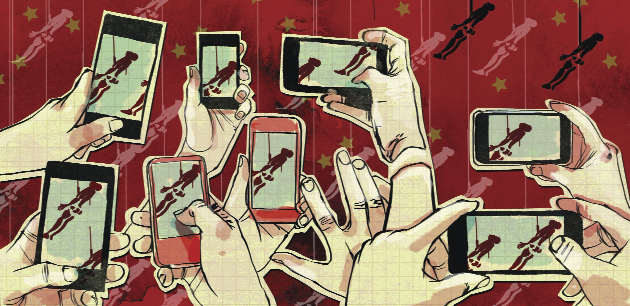How do smart solutions figure in a city’s culture? How are technology and science combined to create a show the audience changes each night? Can companies and government open innovation environments to the public? The BarcelonaLab project brings together a good number of examples that answer these questions.
“And so, after more than a year of siege, at last we reach 11 September, 1714. It started with a terrifying volley of artillery fire at half past four in the morning,” relates a shocked Martí Zuviría in Albert Sanchez Piñol’s book Victus, when he becomes aware of the inevitable defeat.
La Fura dels Baus are all ready to relive the young Zuviría’s agonising moments through their new show M.U.R.S. 1714–2014. Montjuïc Castle will once again experience what happens to a city under siege. “This year we open the Grec Festival and re-enact part of the siege from 300 years ago,” explains Pep Gatell, one of the artistic directors of La Fura dels Baus. In its customary way, the Catalan theatre company will make its audience lose control and react to uncomfortable input. “How do people interact in a siege? How do they move? How do they respond to the revolutionary ideas raised? It is a collective experiment and each performance will be different. We are going to provide a real-time scientific explanation for their movements,” adds Gatell.
“We will measure the degree of the public’s anxiety and see whether they swing to the right or the left, and suggest patterns of behaviour,” explains Josep Perelló, co-ordinator of BarcelonaLab’s Citizen Science Office and one of the 20 scientists from the Physics Faculty at the UB and the CSIC’s MoveLab that will be analysing the public. “Two years ago we studied the movements of hundreds of visitors to the Science and Technology Festival through the Bee-Path project.”
To understand and get involved in the M.U.R.S. show you will need to download their app onto your smartphone, leaving the geolocalisation option open. The wireless network will come courtesy of IGLOR – a technology start-up from Barcelona – and the drones flying around the night sky and recording the show will be contributed by Ars Electrònica. Screens located around the venue will show part of what is happening. The rest will be received on your mobile. “It will be totally manipulated and people will have to take sides. Will we act like our forebears who joined together to avoid being crushed? Or won’t we achieve the necessary harmony?” ask the six directors of La Fura who, after 20 years, are reuniting for this production.
La Fura dels Baus, the scientists from the UB – through the Citizen Science Office – and IGLOR are all taking part in the BarcelonaLab project. “The idea is to create quadruple helix synergies, i.e. between research centres, public administration, companies and the general public,” says Inès Garriga, Director of Creativity and Innovation at the Barcelona Culture Institute (ICUB). “BarcelonaLab should be understood as an umbrella under which there are proposals with very different challenges, which use the showcases and festivals of the city as innovation spaces or labs. At the Grec, the Mercè, the Science Festival and the Dau Festival, the city’s talent for innovating has already been seen.”
This is true of the technological music project Barcelona Soundscapes. Back in 2012, the engineers behind it wanted to make a sound map of the city. A mobile app and a GPS would help them listen to the sounds. “To carry out the project, Pompeu Fabra University (UPF) used the sound database Free Sound, i2Cat allocated a server to host the tool and the Phonos Foundation is now organising workshops for people to record the sounds,” explains Víctor Jiménez, an engineer from i2Cat. The Barcelona Soundscapes idea, which came out of the combination of communities in BarcelonaLab, has already created links with New York, with the Citygram project, where the public can contribute sounds from their homes and view them on a map. “Now, with the music journalist Albert Puig, they are thinking of adding emotions to the sound map. The musicians will create harmonic layers synchronised to a specific place. Each person will have a unique experience as they walk around,” adds Jiménez. “The project is really powerful and can have other applications,” says Alba Rosado, from the Music Technology Research Group at the UPF. “Imagine an app where you could walk past a bar and know what kind of music they played. This is sound branding. Or identifying emblematic buildings like the Liceu or the Boqueria with music linked to their identity.”
Apps to solve cultural challenges
Since mobile phones have been “smart”, cities have filled up with a host of new cultural services aimed at their inhabitants and tourists. City councils see great possibilities in having simple technology available that can lead to interaction and allow them to find out the tastes and needs of the people.
Carles Ferreiro, the founder of the technology company Dotopen, lived for some years in Silicon Valley. He brought the knowledge he gained there to Barcelona and in 2009 he created AppCircus, the global community for mobile app developers. In four years they have already organised 120 events in 50 cities around the world. Dotopen’s formula proposes that services are not only offered by local authorities to the public, but that they themselves become the designers. “City councils should not be like vending machines where we put in money in the form of taxes and get out services.” So, together with the ICUB, last year they held the competition Apps&Culture, where more than 60 ideas were presented and 22 apps were created. The winners were Meetogo, an app to connect people with the same musical tastes, and Unique Visitors, for sharing itineraries of museum visits.
Experiences like these are putting Barcelona on the international map for technology. One of the most notable and recent expressions of this recognition was the European Capital of Innovation Award bestowed on the city by the European Commission. The accolade, which was issued for the first time last March, recognises the capacity for facilitating the connection between the public, the local authority, the academic world and companies. This is the quadruple helix mentioned by Inès Garriga.
To be or not to be smart
Despite the fact that it seems as if technology and culture could also go hand-in-hand with increased creativity linked to innovation, the technologist and activist Evgeny Morozov, author of many books on the evolution of the internet, gives a strong warning about manipulation by the companies in Silicon Valley. They sell us the idea of a perfect life, without conflict or disappointment, through smart products that simplify our lives, making them more practical and intelligent. “Not everything that needs to be arranged should be arranged. The imperfect is also good. If everything was efficient, why would we have to innovate?” According to Morozov, these multinationals are making us lose the capacity to decide, to resolve problems between communities, to defend coexistence or to mantain a certain degree of freedom.
Inès Garriga, driving innovation in Barcelona from the ICUB, fiercely criticises Morozov and urges: “We have to take advantage of the creative talent in the cities. Obviously we cannot only live on technology. In reality it is the people that make cities intelligent.”

© La Fura dels Baus
An illustration of the M.U.R.S. project, the play to be released by La Fura dels Baus theatre company in June, within the framework of the Tercentenary of the Catalan Defeat of 1714. The show aims to make the audience experience the place of Barcelona and invites the spectators to become actors in the play by means of a mobile application.




